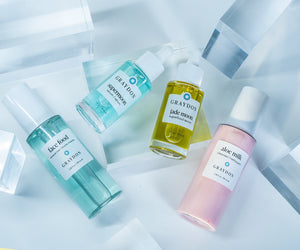Have you ever heard the term “photosensitivity” before?
If not, don’t worry—it’s not always talked about, and its definition might not be obvious at first glance. However, if you’re someone using skincare with a lot of actives in it, it’s definitely something you should know about!
Why? Because you might unknowingly be damaging your skin.
A lot of ingredients that are really great at improving your skin in some ways could also be damaging in others. When your skin is photosensitive, it leaves you more vulnerable to what should be easily avoidable UV damage.
So let’s dive into all things photosensitivity. I’ll explain what the term means, why it’s important to avoid UV damage, and what ingredients do and don’t cause photosensitivity.
What is photosensitivity?
I know I mentioned this just above, but photosensitivity is when your skin becomes more susceptible to UV damage. Another term for this is “sun sensitivity”.
When your skin is photosensitive, you’re more likely to not only get sunburnt, but also experience free radical damage and skin irritation like stinging, itchiness, or even rashes. The former—sunburn and free radical damage—is a result of phototoxicity, while reactions like a rash are attributed to photoallergy.
Either way, the cause of these reactions is the same: exposing your skin to UV rays when the skin is photosensitive. Want a specific example? Imagine going to the beach the day after you get a facial peel, and not remembering to reapply your SPF. Or, you start using a serum in the mornings when the label specifies to only use it at night (which is usually a sign there’s something in it that increases photosensitivity), then you go out in the sun.
What about certain skincare ingredients (most commonly retinol and some exfoliants) makes your skin photosensitive?
Well, it’s because they increase the rate at which your new skin cells come to the surface of your skin to replace the dead ones. This is called cell renewal or cellular turnover, a process that naturally slows down as we age, so usually cell renewal is something we want to try and encourage in our skin to promote healthy aging and counteract any damage that might prematurely slow these processes down.
Photosensitivity is caused by increasing cellular turnover, leading to new, delicate skin cells to appear more often on the surface of the epidermis.
Most ingredients that cause photosensitivity work the same way, either by having the ingredient itself increase cellular turnover or by exfoliating the skin to reveal new skin cells faster.
This means that when you have new, fresh skin cells on the surface of your skin that are more delicate and vulnerable to damage, this is what makes your skin photosensitive. However, it’s important to note that not all ingredients that stimulate cell turnover cause photosensitivity—I will go over specific ingredients below!
Why it’s Important to Avoid UV damage

UV damage is the bad guy in this scenario, something I’m almost positive you already knew. But it helps to have a reminder of what the actual impact to your skin is when you get UV damage, so let’s talk about it.
Antioxidants are an essential part of your skincare regimen because they’re the ultimate protectors against skin damage and accelerated aging.
Essentially, UV rays cause something called free radical damage. This is when free radicals—damaged cells in your body that are missing an electron—attack your healthy cells in an attempt to get their electron back. I think you can guess what happens next: once an electron is stolen, that healthy cell is now also damaged and has to go on its own quest to get a new electron. This sets up a chain reaction of damage that can only be curbed by antioxidants, which neutralize free radicals.
This is why we talk so much about how essential antioxidants are to your skincare regimen.
Antioxidants can also protect against another effect of UV damage: the slowing of collagen and elastin production, which are what gives your skin its firmness, elasticity, smooth texture, and plumpness. This slowing of production is also something that happens naturally as we age.
What Does Long Term UV Damage Look Like on The Skin?
Free radical damage and the slowing of collagen and elastin production disrupt the structural integrity of your skin and can lead to long term effects like fine lines, wrinkles, and slack and crepey skin. UV damage in general can also cause long-lasting hyperpigmentation or dark spots. And, perhaps the most significant impact is the increased risk of developing skin cancer, something our founder, Graydon Moffat, has had to navigate.
There are short term impacts, too. Sunburn, of course. But there’s also inflammation, a damaged skin barrier (which can lead to texture, clogged pores, dryness, acne, and more), and dry, thirsty skin.
Skincare Ingredients That Cause Photosensitivity
Retinol
Retinol is probably the most well known ingredient for aging skin, as it helps minimize the appearance of wrinkles and stimulates collagen and elastin production, giving the skin a fuller, firmer look and a healthy glow.

However, it also leaves skin more sensitive to the sun. That’s because it speeds up cellular turnover—which is good for helping your skin look and feel healthy due to the new cells coming to the surface—but also thins the stratum corneum as a side effect (which is the case for every ingredient that speeds up cell renewal).
Care has to be taken when using retinol. While there are many factors that go into the reasoning behind these restrictions, it’s best practice to:
- Only use retinol at night.
- Avoid daily use (unless your skin has built up a tolerance to it).
- Not use retinol at all if you are pregnant or breastfeeding.
- Condition your skin to retinol by gradually increasing the strength/frequency at which you’re using it.
- Potentially stop using it during hot summer months when you spend time outside, and 7+ days before and after a beach vacation.
Try a Sun Safe Alternative to Retinol: Bio-Retinol
You can swap or supplement your retinol with a bio-retinol like bakuchiol or dew bean (amongst other retinol alternatives that don’t cause photosensitivity). These particular botanical ingredients are called bio-retinols because they are natural alternatives to retinol that have essentially the same benefits, such as improving the appearance of fine lines and wrinkles, firming the skin, fending off acne and breakouts, helping with hyperpigmentation, and more.
Bio-retinols still encourage cell turnover, but they do so in a way that doesn’t cause the same photosensitizing side effects as retinol.
Both bakuchiol and dew bean are included in two of our products. Get a double dose of bio-retinol in Supermoon Serum, which also plumps, soothes, and brightens the skin with its multifunctional blend of ingredients like peptides, collagen, and vegan hyaluronic acid.
These two are also in Phyto Clear, our gel-like moisturizer for combination skin that keeps pores clear, breakouts at bay, and skin firm and plump. The texture of the moisturizer also offers a temporary firming effect to the skin you can enjoy throughout the day.
Alpha Hydroxy Acids (AHAs)
Alpha hydroxy acids—aka AHAs— are chemical exfoliants. Don’t worry, in this case, “chemical” is not a bad word! It just means that instead of physically scrubbing the dead skin off your face, you’re getting an ingredient to do it for you.

AHAs are actually a grouping of ingredients, hence the plural “acids” in the name. There are a number of unique acids under this umbrella term, yet they work the same way—by dissolving the “glue” that holds dead skin cells together, allowing them to slough off.
Because these acids unveil new, baby-fresh, damage-prone skin cells, they increase the photosensitivity of your skin. However, this exfoliation is still good—the increased rate of cell renewal gives the skin a more radiant glow.
Besides, as I said before, cell renewal naturally slows as we age. Speeding it up can help slow down the development of fine lines, wrinkles, crepey and slack skin.
Some common AHAs to keep an eye out for:
- Glycolic acid
- Mandelic acid
- Tranexamic acid
- Lactic acid
- Malic acid
- Citric acid
Try a Sun Safe Alternative to AHAs: Beta Hydroxy Acids (BHAs)
Just like AHAs, BHAs work as chemical exfoliants. The difference is that AHAs slough off old skin cells, while BHAs work by softening and dissolving keratin, a protein that forms part of your skin structure. This is why BHAs, while still chemically exfoliating your skin, are a sun-friendly alternative to AHAs.
On the whole, BHAs also tend to be gentler—a good thing to know if you have sensitive skin. Both AHAs and BHAs are exfoliating, smoothing, brightening, hydrating, acne-clearing, and firming for the skin—and they both help with hyperpigmentation and the appearance of fine lines and wrinkles. That’s a ton of great benefits!
An upper hand BHAs have over AHAs is that they also help regulate sebum production, helping you manage skin that either produces too little (dry) or too much (oily) sebum.
Some popular BHAs include:
- Salicylic acid
- Beta hydroxy butanoic acid
- Willow bark extract
We use willow bark extract in Face Foam, our exfoliating foam cleanser. It’s great at gently decongesting and brightening the skin, and includes other ingredients like azelaic acid and bamboo extract to retexturize your skin.
Psssst. Want to know more about exfoliating acids? Get a comprehensive breakdown on AHAs, BHAs, and even a third category—PHAs—in our article, Can I Use Acids If I Have Sensitive Skin?
How to Handle Photosensitive Skin
At the end of the day, it’s not necessarily bad to use ingredients that cause photosensitivity. It just means you have to take extra precaution when you’re out in the sun.

Here are a few ways you can do that:
- Use SPF vigilantly every day, even in winter.
- Use at least 30 SPF, especially on areas the photosensitizing ingredient was applied to.
- Seek shade during peak sun hours (10am-4pm) and/or when the UV index is. high.
- Wear a hat on sunny days to cover your face (the most likely place you’re using photosensitizing products)—but make sure to still pair this with SPF to be safe!
- Stop using your photosensitizing actives a few days before and after prolonged sun exposure—think cottage weekends, beach vacays, etc!
Even if you aren’t handling photosensitive skin, you should be wearing SPF daily to protect your skin—after all, anyone can get UV damage! And if you don’t want to worry about incurring extra damage, try one of the sun-safe swaps I listed above if you’re thinking of trying a retinol or exfoliating acid.
In Summary
- Photosensitivity means your skin is more vulnerable to UV damage—which can cause sunburn, irritation, fine lines and wrinkles, dark spots, and even skin cancer.
-
Ingredients like retinol and AHAs (glycolic acid, lactic acid, etc.) increase cell turnover, which exposes delicate new skin cells that are easily damaged by the sun.

- Retinol also reduces melanin (your skin’s natural sun shield), making you even more sensitive.
- Try sun-safe alternatives like bio-retinols (bakuchiol, dew bean) or BHAs (like salicylic acid or willow bark extract)—these offer similar benefits with less photosensitivity.
- Always wear broad-spectrum SPF 30+ daily, even in winter, especially if you’re using actives.
- If you want sun-safe skincare, try Supermoon Serum, Phyto Clear Moisturizer, and Face Foam Cleanser.



